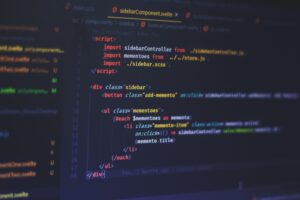Careers in tech are rapidly gaining popularity in the job market, thanks to the ever-growing field and the fulfilling employment options. Today, software development is one of the most sought-after professions, and the demand is just getting better.
Software developers can be categorized into three types; front-end, back-end, and full-stack. Front-end developers work on everything visible to the clients or web and app users. Back-end developers work on code and applications that live on the server, while full-stack developers combine both front-end and back-end development skills.
If you are considering pursuing a career in software development and want to major in back-end development, we’ve rounded up some facts about the niche plus tips and insights to get you started.
What Does Back-end Development Entail?
As mentioned earlier, back-end development is what runs the web from the server-side. It allows you to browse any site on the internet and gets you the exact results you expect. Back-end developers write programs that interface the server, the application, and the database. They are also responsible for any necessary updates or changes needed for the program or site to work efficiently.
Most back-end developers have a basic understanding of front-end technologies such as JavaScript, HTML, and CSS. This is because they often partner with front-end developers, and they need to use web application frameworks that integrate well with the intended front-end designs. The same knowledge is also necessary to better configure the APIs and server-side architecture for effective communication and seamless integration.
What Does It Take to Be a Backend Developer?
Becoming a back-end web dev isn’t as difficult as it may seem. All you need are technical skills and a good understanding of back-end development aspects. These include:
Back-end Programming Languages
Coding is one of the basic necessities to becoming a web developer. For your computer to implement algorithms and execute given instructions, it needs to run on some code. Here are the most common programming languages for server-side development;
- PHP (Hypertext Preprocessor) – This is the most common language used in over 78% of websites. That means nearly 8 in every 10 websites on the internet uses PHP in one way or the other. This scripting language automates routine processes, generates dynamic page content, and improves application performance.
- Java – This is a cross-platform server-side programming language that allows you to write and run code anywhere with great performance. High-end companies like Amazon, Netflix, and Uber use the language in their back-ends.
- Python – As one of the latest languages for back-end development, python emphasizes code readability, thanks to the vast libraries and frameworks. Its syntax allows developers to work efficiently with intricate systems. It also supports convenient collaboration on projects.
Data Structures & Algorithms
Back-end development is data-driven, and you need a good command of the algorithms and processes used to execute and display data on the server side. When clients make data requests, the back-end system acts as the middleman by retrieving a valid response from the database and sending it back to the client. Similarly, you need to have some skills and experience handling databases used to store, organize and save large files and data.
Having a background in common database systems like Oracle, MongoDB, and Redis will help you with DBMS technology. For data caching techniques, you’ll need knowledge in varnish, Redis, and Memcached.
API Knowledge
APIs are increasingly becoming popular in software development. An API (Application Programming Interface) acts as a link that allows two applications to communicate. APIs also allow developers to open up data and functionalities to other developers and businesses. Similarly, knowledge in web services such as REST (Representational State Transfer) and SOAP (Simple Object Access Protocol) will be an added advantage.
Day to Day Responsibilities of a Back-end Developer
Back-end software development, like any other tech-oriented career, comes with a ton of responsibilities. A typical workday of a back-end software developer is spent writing, editing, or testing code and making the necessary improvements to existing projects. As a technical career, the duties require some creativity and are quite dynamic, considering the projects to be developed do vary based on client needs.
That said, here are some of the typical responsibilities of a back-end software developer:
- Database management – This encompasses everything from database creation, integration to maintenance. Database management systems allow users to retrieve and even update data with ease. Back-end developers ensure that these systems are running efficiently and as required.
- Choosing server-side web framework – Every software development project comes with unique needs. A back-end developer is responsible for choosing the right web application framework to make it easier to write, maintain and scale the web or mobile application.
- Cloud computing integration – Digital transformation has seen a rapid shift to the cloud, and most applications and enterprise software now reside in the cloud. Back-end developers are responsible for strategizing and implementing cloud app integration. This requires knowledge in Integration Platform as a Service (iPaaS) and application and cloud security.
- Content Management System (CMS) Development – Every CMS has an admin dashboard that allows for administrative functions. Most back-end developers interact with the CMS, and they may be required to make some tweaks and customization to suit the client’s needs. Troubleshooting these systems is the other responsibility that back-end developers have.
- Back-end Testing – This is a testing activity designed to check all the server-side parameters for a smooth transition. Developers can resolve sensitive complications through back-end testing such as data corruption, data loss, and deadlock. Anyone running back–end testing should be well-versed in databases and servers. Knowledge of structured query language (SQL) and other scripting languages is quite crucial. This makes the job suitable for any competent back-end developer.
- Security settings and hack prevention – In today’s tech field, cybersecurity is increasingly becoming a must-have skill. Forward-looking software development companies prioritize security by design, meaning every developer must understand cybersecurity. And while back-end developers don’t need to have deep knowledge of cybersecurity as IT professionals, their work would be a little easier if application security were their competence.
- Reporting, analytics, and statistics – Dealing with data mean you’ll have to interact with some form of analytics and statistics software. Back-end developers need knowledge of back–end analytics, which may vary depending on the industry or niche you are in. For instance, in marketing, Back-end analytics would look at the click rates, customer engagement, and bounce rate.
- Restore, upgrade, and backup of systems – Back-end developers are responsible for restoring and backing up the website’s files and database systems. They also handle upgrades of the server, the app, and the databases. This demanding and highly sensitive operation is needed to ensure the optimum and secure running of processes.
Is Back-end Software Development Right for You?
If you are thinking of joining the tech field, you have probably made a choice that your future self will thank you for. Even then, the ultimate decision to choose back-end software development instead of front-end or even full-stack can be daunting. Unless you are well-versed in the nuances of software development, you may want to take some time to compare the two before making up your mind.
If you are lost for options, leveraging the differences in personality types and temperaments may not serve as the perfect predictor of what will work best for you, but they will guide your decision-making, pointing out what may suit you the most.
That said, most people who prefer to create visually appealing designs may choose to become front-end developers to work on UI or UX development. This client-facing role requires people with a taste for quality and high-level creativity. Most front-end developers have an artistic eye, and they love making things appear flashy and pretty. On the other hand, people who love to deal with structured data, are investigative, and are detail-oriented would make good back-end developers.
As a back-end developer, you’ll be mainly dealing with three core areas of software development – servers, apps, and databases. This, however, doesn’t mean you won’t need any knowledge of front-end development. Throughout the software development career, you are more likely to collaborate with front-end developers, and having some basic understanding of this niche would make your work easier.
For some, front-end languages such as JavaScript feel less organized. So they would instead go for easy-to-use back-end languages such as python or clean and well-structured ones like Ruby. Either way, the goal would be to optimize code performance to make things run faster and better.
Get Started Today
Back-end software development is a promising tech field that’s not only fulfilling but also quite rewarding. The choice to pursue this career option will partly depend on what you want your day-to-day responsibilities to look like. And since software development careers have a more common background, you can always switch from one specialty to the other with little to no difficulties. This will often require that you learn some new coding skills and gain experience in that particular field. To become a back-end software developer, you’ll need to major in programming languages such as Java, Python, Ruby, PHP, and C #. You can always start by learning and mastering one coding language before moving to the other. The problem with this type of learning is that you won’t follow any learning guide or curriculum and may be less effective than signing up with a coding class. Whether you’ll choose a physical or virtual coding and design class, you want to maximize your time learning the most relevant skills. That way, you’ll not only gain the most valuable and in-demand coding skills, but you’ll also fast-track your way to the job market.
What you might be interested in: What Is A Docker Used For: Beginners Full guide (2022)
How useful was this post?
Click on a star to rate it!
Average rating 5 / 5. Vote count: 2
No votes so far! Be the first to rate this post.


